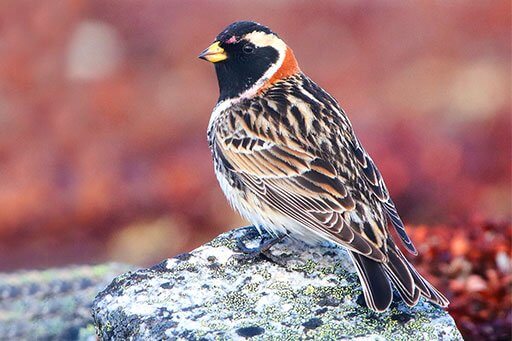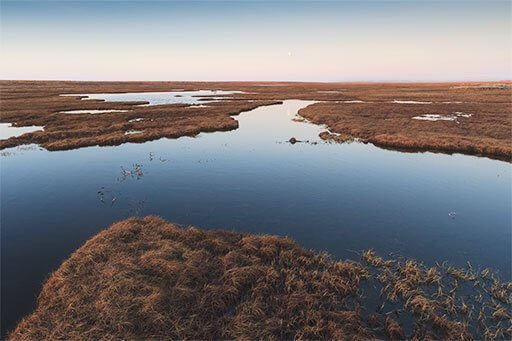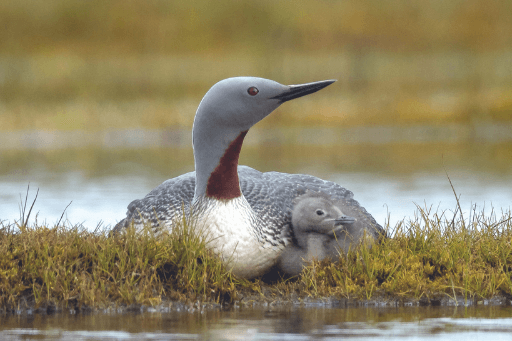The Changing Tundra and What It Means for Birds
Many birds nest only in this treeless biome. As the planet warms, what is at stake and how might they fare?
Beyond where stunted conifers surrender to bitter winds and frozen soil lies a region of extremes. There, tiny, hardy plants blanket the terrain for thousands of miles, and a diversity of habitats nurtures billions of birds. This land of eternal sun, or darkness, is the tundra.
To many, the tundra may be both physically distant and far from mind. Yet many of the birds that delight us hail from there. As you'll read here, the future of tundra-nesting birds is inextricably tied to the fate of this biome — and that future is in flux.

What Is Tundra?
Covering an estimated 10 percent of Earth's surface, primarily in the Northern Hemisphere, tundra occurs in polar and alpine (mountainous, high-elevation) areas. In both situations, cold temperatures, strong winds, snow cover, and short growing seasons result in open landscapes that give the biome its name, which is derived from the Sami word tūndar, meaning “treeless hill.” (The Sami culture is centered in the tundra of northern Scandinavia.) Permafrost, perennially frozen soil, is a ubiquitous feature in these areas, and in place of trees, tundra regions are rich in dwarf shrubs, grasses, herbaceous plants, mosses, ferns, and lichen.

Within North America, Arctic tundra covers northern Alaska, Yukon, the Arctic islands of Canada, portions of the mainland of the Northwest Territories, Nunavut, and northern Quebec. The terrain across this broad mantle of land is highly variable, ranging from vast plains, rolling lowlands, and ice-covered lakes to flat-topped mountains and snow-free uplands. Expansive wetlands are common, particularly in shield or bedrock regions of eastern and central Canada.
The North American tundra is the homeland of many Indigenous peoples, including the Aleut, Yupik, and Inupiat in Alaska, and the Inuit (Inuvialuit) in Canada, who depend on healthy populations of fish, mammals, and birds for subsistence harvesting.
Bird populations are particularly abundant there, especially during productive summer periods, when more than 135 species breed across North American tundra. (Across the world's Arctic region, the figure may reach 200 species.) Geese and shorebirds often dominate tundra bird communities, but other representative species include Yellow-billed and Red-throated Loons, Long-tailed Duck, King Eider, Peregrine Falcon, Parasitic Jaeger, Snowy Owl, Willow and Rock Ptarmigans, Hoary Redpoll, Lapland Longspur, and Snow Bunting.

Together, the tundra's unique fauna, inaccessibility, and extreme physical environments lend to its mystique. But the Arctic tundra warrants our attention for more practical reasons as well because it plays a global role in carbon-cycling and temperature regulation.
Permafrost — a subsurface mixture of frozen sediment and organic matter — is the common thread unifying tundra habitats. Because it remains frozen year-round, with only a thin surface layer that briefly thaws each summer, permafrost serves as a carbon sink, effectively locking away surplus carbon in long-term cold storage, as sub-zero temperatures hinder decomposition and the release of greenhouse gases. Wetlands are particularly important in this regard: They make up an estimated 60 percent of Arctic tundra habitats and store particularly large amounts of carbon and other nutrients, while also providing a figurative oasis on the typically dry landscape.
A Changing Climate
The recipe for distinctive tundra ecosystems requires the combination of sub-freezing mean annual temperatures, large annual temperature ranges, and moderately low precipitation from 4 to 10 inches per year — much of which falls in the winter as dry, powdery snow. These relatively predictable conditions are now coming under threat as the climate changes.

Since the 1950s, annual precipitation has increased in Arctic regions, and annual average air temperatures have increased twice as fast in the Arctic as elsewhere in the world. Climate scientists agree that we are in an era of climate change, with many locations undergoing a warming trend. The United Nations' Intergovernmental Panel on Climate Change now predicts that without intervention, Earth's surface will warm by 1.5˚C (2.7˚F) by the mid-2030s, with current models predicting early and disproportionately large changes in climate at high northern latitudes. Arctic soil freeze-thaw cycles are also changing, with the most dramatic changes observed in the depth of the active layer — the soil layer that freezes and thaws on an annual basis — being noted at the northern part of the permafrost region.
As permafrost thaws, organic matter and carbon locked within become active. This means that vast sinks of carbon are now becoming carbon sources as peat and organic matter begin to rot. Microorganisms consuming organic matter produce carbon dioxide and methane, greenhouse gases that can further accelerate warming. Based on recent modeling by the National Oceanic and Atmospheric Administration, 300 to 600 million tons of carbon globally may be expelled from thawing permafrost per year.
Although the specific impacts of warming and permafrost thaw on the flora and fauna of the tundra are not well understood, changes in water availability, mobilization of contaminants, earlier onset of spring, and the introduction of new species will all present new and unknown challenges to Arctic-nesting birds.
Wetlands Washing Away
Ground ice and permafrost are important for the maintenance of extensive wetlands throughout the tundra. Ground ice is formed when water infiltrates cracks in peat and then refreezes. Over time, these wedges of ice can block or slow down moving water, creating a mosaic of wetland types ranging from shallow lakes to extensive fens and wet meadows on which many nesting bird species depend. However, as the climate warms, in-ground ice is eroded, leading to changes in the structure of Arctic wetlands.

In the short term, depressions remaining in the wake of thawing ground ice may create new wetland areas. But in the long term, when the natural damming effect of ground ice is lost, the increased connectivity drains wetlands more quickly, reducing habitat and food availability for many species of nesting birds, including the Dunlin, Red-necked Phalarope, King Eider, and Red-throated Loon.
Changes in water availability, however, are likely to impact more than wetland birds: During a nine-year monitoring project in northern Canada, for example, over one-quarter of Rough-legged Hawk nests collapsed, apparently correlated to heavy rain events, which are expected to occur more frequently on the tundra as the climate warms.
Toxins on the Tundra
Climate change will also affect levels of heavy metals and other environmental contaminants in tundra landscapes, representing another threat to the health of Arctic-nesting birds. On the tundra, many contaminants arrive after being transported via water and air from far-away sources, in a phenomenon called the “grasshopper effect.”
Mercury, in particular, is one such contaminant of concern because it can impact many biological systems, including neurological functions, and adversely affect survival, reproduction, and development. Furthermore, mercury becomes more biologically available and more toxic in wetlands with lots of decaying organic matter and peat. In this way, breeding birds are likely to face an increased risk of exposure to mercury and other contaminants on a warming tundra. How this will impact populations remains unknown.
Until recently, most studies that monitor contaminants in Arctic regions have focused on large seabirds and other marine predators. Elevated mercury levels, however, are now being recorded in other species, including those that nest on mainland tundra away from marine inputs. Red-throated Loons and other fish-eating species tend to have higher levels of mercury than do other freshwater species, since mercury biomagnifies in food chains — meaning predatory species can acquire this toxin from the foods they eat. Mercury and other pollutants have also been documented in tundra-nesting shorebirds like the Sanderling and Semipalmated and White-rumped Sandpipers, which forage on invertebrates in shallow wetlands where contaminants can accumulate.

Will Early Birds Still Get the Worm?
Since the productive spring and summer seasons on the tundra are short, migrating birds need to have their timing just right, arriving and breeding so that their young hatch when food is most plentiful. Whether or not birds can adjust arrival and breeding schedules and adapt to earlier spring conditions is an important question for bird conservation, and the answer seems to be mixed.

Some species, like sandpipers, phalaropes, and the Lapland Longspur, do tend to breed earlier in years of earlier snow melt. Other species, like the Brant, Snow Goose, and Dunlin, seem to have more rigid dates of breeding that are possibly related to migration distance, and this may result in a mismatch between timing of reproduction and climate-induced changes in the timing of food availability. Further, as the climate warms, weather events also become less predictable, meaning that food availability for growing chicks isn't guaranteed even for early nesters.
Landbird species reliant upon camouflage in their highly seasonal tundra habitats face additional challenges due to the earlier onset of spring and disappearing snowpack. Rock Ptarmigans, for example, undergo a dramatic shift in coloration, molting from white to brown plumage as winter melts into spring. This shift is usually associated with photoperiod — the amount of sunlight at a given time — and is not directly linked to temperature or the amount of snow on the landscape. Cryptically colored to match their winter wonderland, male ptarmigans retain their bright white plumage longer into the spring than do females. While attractive to their female mates, these males more easily draw the attention of predators such as Gyrfalcons and other raptors. Before males fully molt into their brown summer colors, they actively dirty their feathers to become less conspicuous. However, as northern habitats continue to change, it's unclear whether male ptarmigans will begin this behavior sooner, and in years when snow melt happens early, these animals may be dangerously conspicuous on the tundra landscape.
Northern Exposure
As the Arctic growing season lengthens, shrubs like alder, willow, and Dwarf Birch are quickly expanding their ranges northward into the tundra. This alters habitats used by Arctic-nesting birds, and the foods that are available to them. Low-shrub tundra habitats, for example, support unique arthropod communities, with a greater abundance of large species, such as spiders and beetles, compared to taller-shrub arthropod communities that predominantly consist of smaller flies. How exactly shrub encroachment will affect nesting birds is an active area of study, with many questions remaining.
There are some guesses about how this might go. Tundra species, such as the Lapland Longspur, which prefers to nest in low shrubs, may be forced to compete with species more adapted to higher-shrub canopies, such as the White-crowned Sparrow. Ground-foraging, tundra-specialized bird species like sandpipers and plovers may abandon areas with extensive high-shrub canopy. With respect to bird species diversity, however, tundra shrub encroachment may initially be advantageous, expanding available niches at least for a little while in transitioning landscapes.

Shrubs aren't the only biota undergoing range shifts in response to a changing Arctic climate. As sea-ice melts and longer ice-free seasons limit when Polar Bears can hunt their preferred seal prey, these apex predators are increasingly turning to terrestrial, inland sources of food. In recent years, Polar Bears have been observed feeding in bird nesting colonies, consuming eggs of geese and the Common Eider, Thick-billed Murre, and Glaucous Gull. In some cases, bears can be a significant cause of nest failure and reduced reproductive success for tundra birds, which do not appear to be adjusting nesting locations to deal with this emerging threat. Given that consumption of eggs alone, however, is insufficient to provide bears with the energy they need, the behavior may be a transient phenomenon; effects on bird communities at broader spatial scales are unknown.
For now, the tundra in North America, and elsewhere, remains a place of majesty, where culturally rich societies, physically extreme landscapes, and diverse wildlife are uniquely interconnected. Yet, we are entering unknown territory for conservation of this biome and its highly specialized bird fauna. In the face of ongoing environmental change, understanding whether abundant populations of tundra birds can stay resilient is a challenge that warrants global attention. It's difficult to protect something if we don't understand it, and climate change presents an ever-moving target of unknowns. Continuing to monitor how tundra birds and other organisms respond and adapt to climate change informs conservation efforts. Additionally, reducing our global emissions so that we do not exceed the 1.5-degree-Celsius warming threshold would bode well for not just tundra birds, but all of us.
 | Katelyn Luff, a wildlife biologist and photographer based in Saskatoon, Canada, completed her master's studying mercury levels in nesting shorebirds in the Canadian central Arctic. |
 | Dr. Kirsty Gurney, who works for the Wildlife and Landscape Science Directorate at Environment and Climate Change Canada, has had the good fortune to work in the central and western Arctic for almost two decades. She is grateful for every frozen second. |


















































